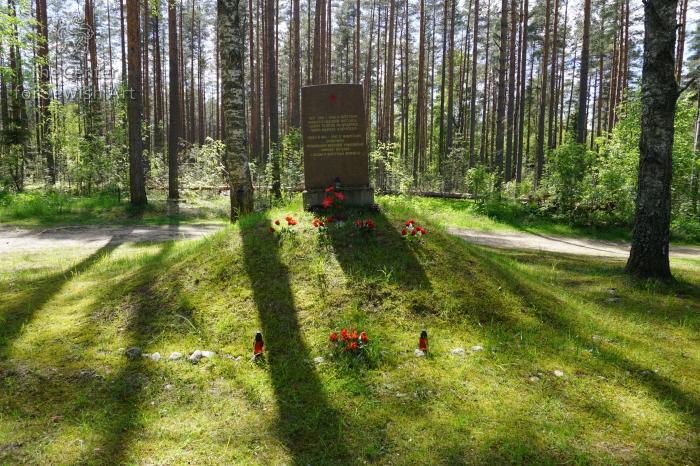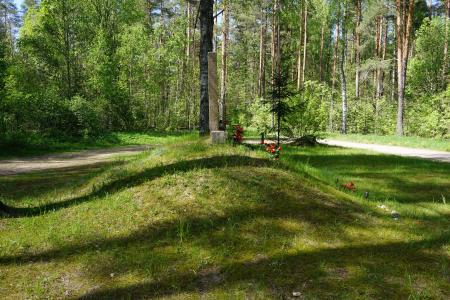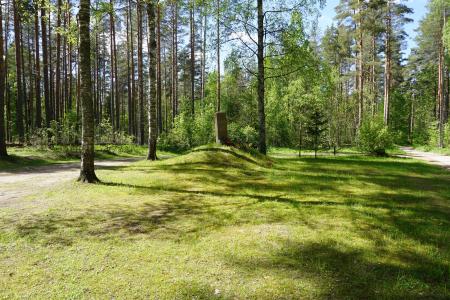Obj. ID: 51666
Memorials Holocaust Memorial at the Garbari Forest near Ludza, Latvia, 1961

Memorial Name
No official name
Who is Commemorated?
The last inmates of the Ludza Ghetto murdered on this site.
Description:
The monument is a stele of red granite, with a five-pointed star and inscriptions in Latvian and Russian.
Inscription
Latvian
Šeit 1941 – 1942 g. fašistiskie
iebrucēji masveidīgi iznīcināja
Ludzas pilsētas un apkārtnes
sādžu mierīgos iedzīvotājus
Translation: Here in 1941-1942, Fascist invaders massively destroyed the peaceful inhabitants of the city of Ludza and its surroundings
Russian
Здесь в 1941 – 1942 гг. фашистские
захватчики
производили массовое уничтожение
мирных жителей
г. Лудзы и окрестных деревень
Translation: Here in 1941-1942, Fascist invaders conducted mass destruction of the peaceful inhabitants of the city of Ludza and surrounding villages
Commissioned by
Authorities of the Latvian Soviet Socialist Republic (?)
sub-set tree:
The Nazi German troops entered Ludza on 3 July 1941. On the following day, arrests of Jewish refugees and “Soviet activists” began. 25 people from among the arrestees were shot on the outskirts of the town, in the vicinity of a brick factory, on July 15, 1941. A ghetto was established in Ludza in mid-July 1941. 35 old Jews, including rabbi Benzion Don Ihie, were shot at the end of July 1941 at the intersection of Rēzekne St. with Parka St, Liepājas St., and Rupniecibas St. After the war, they were reinterred in the Jewish cemetery. 10 more Jews were shot at “Lauderi” farm at the end of July 1941. They were also reinterred in the Jewish cemetery.
A mass murder of Jews from the Ludza ghetto took place in mid–August 1941, when about 600 people were taken to the Cirma Lake (about 7 km from Ludza) and shot. 40 more Jews were shot there on August 27, 1941. In October 1941 part of the remaining ghetto inmates were sent to Daugavpils, some were shot near Dzerkaļi village, and others were shot near Kotāni village on November 13, 1941. The last inmates of the ghetto were murdered in Garbari Forest on April 3, 1942.
A monument on the murder site was erected in 1961 (Holocaust Memorial Places in Latvia).
In the 1970s, commemorative events in Ludza were reported in the Soviet Latvian press (Zeltser, 199).
"Holocaust Memorial Places in Latvia," a website by the Center for Judaic Studies at the University of Latvia, http://memorialplaces.lu.lv/memorial-places/latgale/ludza-municipality-the-garbari-forest/.
Lenskis, Ilja, Holokausta piemina Latvijā laika gaitā 1945–2015 = Holocaust Commemoration in Latvia in the Course of Time, 1945–2015 (Riga: Muzejs “Ebreju Latvija,” 2017)
Meler, Meyer, Mesta nashei pamiati: Evreiskie obshchiny Latvii, unichtozhennye v Kholokoste (Riga: by the author, 2010), pp. 271-272.
Rochko, Josif, Jewish Latgale: Guidebook (Daugavpils, by the author, 2018), p. 40.
Zeltser, Arkadi, Unwelcome Memory: Holocaust Monuments in the Soviet Union, trans. A.S. Brown (Jerusalem: Yad Vashem, 2018), p. 199.









